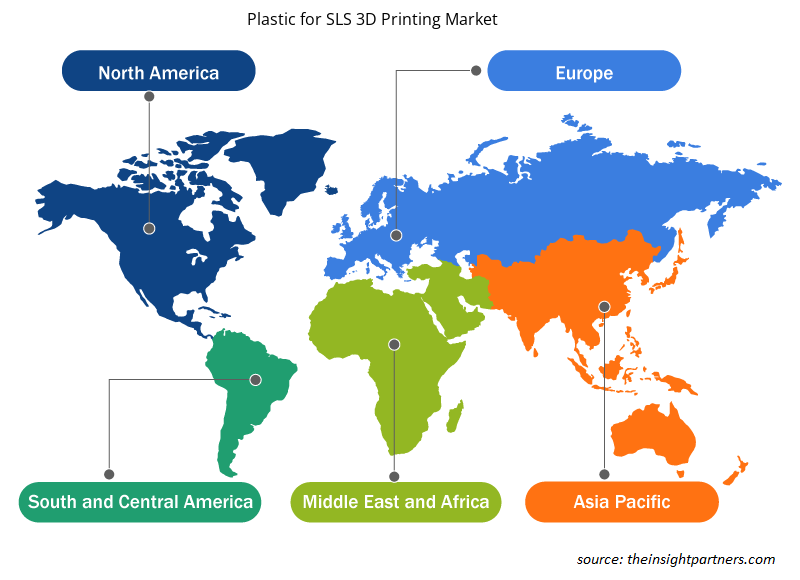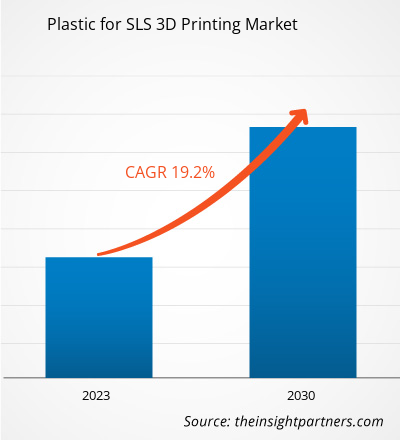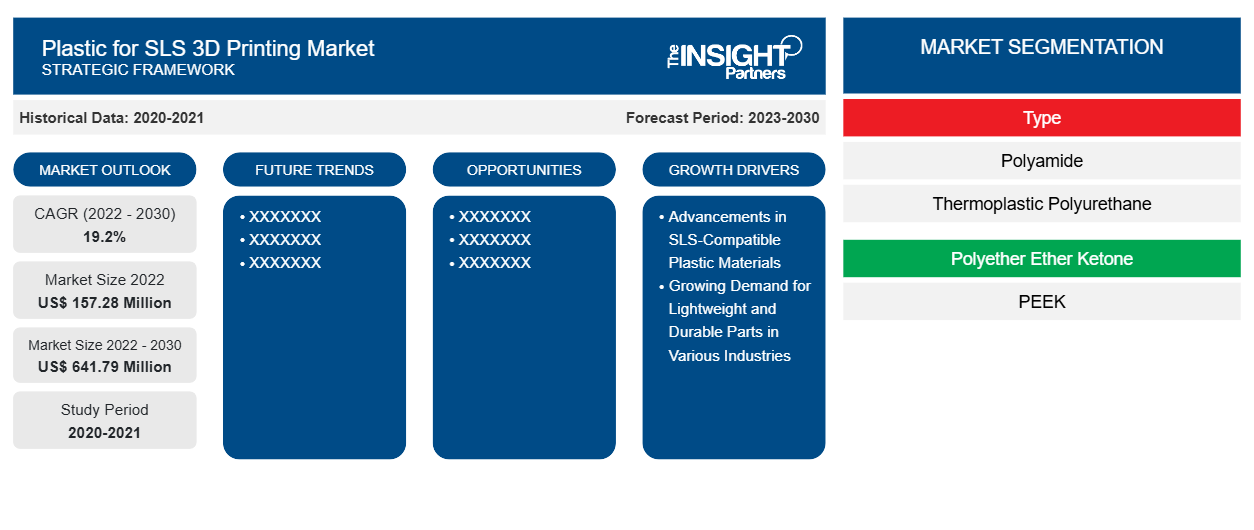[تقرير بحثي] تم تقييم حجم سوق البلاستيك للطباعة ثلاثية الأبعاد SLS بنحو 157.28 مليون دولار أمريكي في عام 2022 ومن المتوقع أن يصل إلى 641.79 مليون دولار أمريكي بحلول عام 2030؛ ومن المتوقع أن يسجل معدل نمو سنوي مركب بنسبة 19.2٪ من عام 2022 إلى عام 2030.
تحليل السوق
التلبيد الانتقائي بالليزر (SLS) هو تقنية تصنيع مضافة تستخدم ليزرًا عالي الطاقة لتلبيد مسحوق البوليمر في بنية صلبة بناءً على نموذج ثلاثي الأبعاد. تعد الطباعة ثلاثية الأبعاد بتقنية SLS خيارًا شائعًا للمهندسين والمصنعين. المادة الأكثر شيوعًا للطباعة ثلاثية الأبعاد بتقنية SLS هي النايلون. النايلون عبارة عن مادة ترموبلاستيكية هندسية عالية الكفاءة للنماذج الأولية الوظيفية والإنتاج النهائي. كما أنها مثالية للتجميعات المعقدة والأجزاء المتينة ذات الاستقرار البيئي العالي. تُستخدم الطباعة ثلاثية الأبعاد بتقنية SLS على نطاق واسع في مجموعة واسعة من الصناعات، بما في ذلك الهندسة والتصنيع والرعاية الصحية وغيرها. العوامل الرئيسية التي تدفع نمو البلاستيك لسوق الطباعة ثلاثية الأبعاد بتقنية SLS هي التطورات في المواد البلاستيكية المتوافقة مع SLS والطلب المتزايد على الأجزاء خفيفة الوزن والمتينة في مختلف الصناعات.
محركات النمو والتحديات
إن التقدم في المواد البلاستيكية المتوافقة مع SLS والطلب المتزايد على الأجزاء خفيفة الوزن والمتينة في مختلف الصناعات هي بعض العوامل التي تعزز نمو سوق البلاستيك العالمي للطباعة ثلاثية الأبعاد SLS. تركز العديد من الشركات على التطوير المستمر للمواد البلاستيكية المتوافقة مع SLS ذات الخصائص المحسنة، مثل المتانة ومقاومة الحرارة والمرونة. على سبيل المثال، تعاونت شركات مثل HP وBASF لتطوير مواد SLS المبتكرة. في مجال الطيران، حيث يعد تقليل الوزن من أهم الاهتمامات لتحسين كفاءة الوقود، اكتسبت المكونات البلاستيكية المنتجة من SLS قوة جذب. على سبيل المثال، قامت شركة إيرباص بدمج الأجزاء البلاستيكية المطبوعة بتقنية SLS ثلاثية الأبعاد في طائرات A350 XWB، بما في ذلك الأقواس ومكونات القنوات، والتي تساهم في تقليل الوزن دون المساس بالقوة أو السلامة. كما تبنت صناعة السيارات أيضًا الأجزاء البلاستيكية SLS. وبالتالي، فإن النمو القوي في الطلب على الأجزاء البلاستيكية خفيفة الوزن من مختلف الصناعات يدفع الحاجة إلى البلاستيك للطباعة ثلاثية الأبعاد SLS، وبالتالي تغذية نمو السوق.
إن تكلفة المواد البلاستيكية عالية الجودة المتوافقة مع SLS يمكن أن تعمل كرادع للشركات التي تهتم بالتكلفة والتي تفكر في اعتماد هذه التكنولوجيا. وفي حين توفر SLS العديد من المزايا، بما في ذلك القدرة على إنتاج أجزاء معقدة بقوة ومتانة، فإن سعر المواد يمكن أن يكون عاملاً مهمًا في عملية اتخاذ القرار. وبالتالي، فإن التكلفة العالية للمواد البلاستيكية المتوافقة مع SLS تحد من استخدامها في قطاعات تطبيقية مختلفة، مما يعيق نمو سوق البلاستيك للطباعة ثلاثية الأبعاد باستخدام SLS.
قم بتخصيص هذا التقرير ليناسب متطلباتك
ستحصل على تخصيص لأي تقرير - مجانًا - بما في ذلك أجزاء من هذا التقرير، أو تحليل على مستوى الدولة، وحزمة بيانات Excel، بالإضافة إلى الاستفادة من العروض والخصومات الرائعة للشركات الناشئة والجامعات
-
احصل على أهم اتجاهات السوق الرئيسية لهذا التقرير.ستتضمن هذه العينة المجانية تحليلاً للبيانات، بدءًا من اتجاهات السوق وحتى التقديرات والتوقعات.
تقسيم التقرير ونطاقه
"تحليل وتوقعات السوق العالمية للطباعة البلاستيكية SLS حتى عام 2030" هي دراسة متخصصة ومتعمقة مع التركيز بشكل كبير على اتجاهات السوق العالمية وفرص النمو. يهدف التقرير إلى تقديم نظرة عامة على السوق العالمية مع تقسيم السوق التفصيلي على أساس النوع والصناعة النهائية والجغرافيا. يقدم التقرير إحصائيات رئيسية حول استهلاك البلاستيك للطباعة البلاستيكية SLS ثلاثية الأبعاد في جميع أنحاء العالم، جنبًا إلى جنب مع الطلب عليها في المناطق والبلدان الرئيسية. بالإضافة إلى ذلك، يقدم التقرير تقييمًا نوعيًا للعوامل المختلفة التي تؤثر على أداء سوق الطباعة البلاستيكية SLS ثلاثية الأبعاد في المناطق والبلدان الرئيسية. كما يتضمن تحليلًا شاملاً للاعبين الرئيسيين في سوق الطباعة البلاستيكية SLS ثلاثية الأبعاد وتطوراتهم الاستراتيجية الرئيسية. يتم تضمين تحليل ديناميكيات السوق أيضًا للمساعدة في تحديد العوامل الدافعة الرئيسية واتجاهات السوق والفرص المربحة، والتي بدورها تساعد في تحديد جيوب الإيرادات الرئيسية.
يوفر تحليل النظام البيئي وتحليل القوى الخمس لبورتر رؤية بزاوية 360 درجة لسوق الطباعة البلاستيكية ثلاثية الأبعاد العالمية، مما يساعد على فهم سلسلة التوريد بأكملها والعوامل المختلفة التي تؤثر على نمو السوق.
التحليل القطاعي
ينقسم سوق البلاستيك العالمي للطباعة ثلاثية الأبعاد SLS على أساس النوع وصناعة الاستخدام النهائي. بناءً على النوع، يتم تقسيم سوق البلاستيك للطباعة ثلاثية الأبعاد SLS إلى بولي أميد وبولي يوريثين حراري (TPU) وبولي إيثر إيثر كيتون (PEEK) وغيرها. شكلت شريحة البولي أميد حصة كبيرة من سوق البلاستيك للطباعة ثلاثية الأبعاد SLS في عام 2022. يعد البولي أميد مادة مفضلة للطباعة ثلاثية الأبعاد SLS نظرًا لصفاته الاستثنائية وقدرته على التكيف. من بين الأنواع المختلفة من البولي أميد المستخدمة في SLS، يعتبر البولي أميد 12 (PA12) شائعًا بشكل خاص. يتم استخدامه بشكل أساسي لقوته ومرونته ومقاومته للمواد الكيميائية والحرارة، مما يجعله خيارًا مثاليًا لمجموعة واسعة من التطبيقات. يعد البولي يوريثين الحراري (TPU) مادة متعددة الاستخدامات وشائعة بشكل متزايد في سوق الطباعة ثلاثية الأبعاد SLS. TPU هو نوع من المطاط الصناعي الذي يتميز بتوازن رائع بين المرونة والمتانة والقدرة على التحمل، مما يجعله مناسبًا لمجموعة واسعة من التطبيقات. في سوق الطباعة ثلاثية الأبعاد SLS، تقدم PEEK مجموعة فريدة من الخصائص التي تميزها عن المواد البلاستيكية الحرارية الأخرى.
من حيث صناعة الاستخدام النهائي، يتم تقسيم السوق إلى الرعاية الصحية، والفضاء والدفاع، والسيارات، والإلكترونيات، وغيرها. علاوة على ذلك، احتل قطاع الإلكترونيات حصة كبيرة من سوق البلاستيك للطباعة ثلاثية الأبعاد SLS في عام 2022. توفر تقنية الطباعة ثلاثية الأبعاد SLS العديد من المزايا لإنتاج مكونات إلكترونية معقدة ومخصصة وصغيرة الحجم. تُستخدم الطباعة ثلاثية الأبعاد SLS القائمة على البلاستيك بشكل أساسي في تصنيع العبوات والأغلفة المخصصة للإلكترونيات الاستهلاكية. تتمثل الميزة الأساسية لاستخدام البلاستيك في الطباعة ثلاثية الأبعاد SLS لقطاع السيارات في قدرته على إنتاج أجزاء معقدة وخفيفة الوزن تلبي معايير الأداء والسلامة الصارمة في الصناعة. تلعب المواد البلاستيكية دورًا حيويًا في مجال الطباعة ثلاثية الأبعاد SLS سريع النمو في قطاع الرعاية الصحية. يتم استخدام هذه البوليمرات متعددة الاستخدامات على نطاق واسع في تطبيقات مختلفة نظرًا لتوافقها الحيوي وسهولة التخصيص وفعاليتها من حيث التكلفة.
التحليل الإقليمي
يقدم التقرير نظرة عامة مفصلة على سوق البلاستيك العالمي للطباعة ثلاثية الأبعاد SLS فيما يتعلق بخمس مناطق رئيسية - أمريكا الشمالية وأوروبا وآسيا والمحيط الهادئ (APAC) والشرق الأوسط وأفريقيا (MEA) وأمريكا الجنوبية والوسطى. شكلت أوروبا حصة كبيرة من سوق البلاستيك للطباعة ثلاثية الأبعاد SLS وقُدرت قيمتها بأكثر من 55 مليون دولار أمريكي في عام 2022. تبحث صناعة السيارات في أوروبا باستمرار عن طرق لتقليل وزن المركبات لتحسين كفاءة الوقود والأداء. علاوة على ذلك، من المتوقع أن تدفع صناعة السيارات المتنامية في المنطقة الطلب على البلاستيك للطباعة ثلاثية الأبعاد SLS. من المتوقع أن يصل سوق البلاستيك للطباعة ثلاثية الأبعاد SLS في منطقة آسيا والمحيط الهادئ إلى أكثر من 110 مليون دولار أمريكي بحلول عام 2030. تعد منطقة آسيا والمحيط الهادئ موطنًا لبعض أكبر اقتصادات التصنيع في العالم، مثل الصين واليابان وكوريا الجنوبية. تستثمر هذه البلدان بكثافة في تقنيات التصنيع المتقدمة مثل الطباعة ثلاثية الأبعاد SLS. كما تتمتع المنطقة بوجود شركات التصنيع الإضافي والطباعة ثلاثية الأبعاد SLS، ومن المتوقع أن يعزز ذلك نمو سوق البلاستيك للطباعة ثلاثية الأبعاد SLS خلال فترة التوقعات. ومن المتوقع أن يسجل سوق البلاستيك للطباعة ثلاثية الأبعاد SLS في أمريكا الشمالية معدل نمو سنوي مركب بنسبة ~18٪ من عام 2022 إلى عام 2030. ومن المتوقع أن يعزز وجود شركات الطباعة ثلاثية الأبعاد SLS في المنطقة الطلب على البلاستيك للطباعة ثلاثية الأبعاد SLS. وتضع شركات الطباعة ثلاثية الأبعاد SLS استراتيجيات لتوسيع الأعمال لتلبية الطلب المتزايد من الصناعات النهائية. ومن المتوقع أن يخلق نمو صناعات السيارات والطيران في المنطقة فرصًا مربحة لسوق البلاستيك للطباعة ثلاثية الأبعاد SLS في السنوات القادمة.
تطورات الصناعة والفرص المستقبلية
فيما يلي قائمة بالمبادرات المختلفة التي اتخذها اللاعبون الرئيسيون العاملون في سوق الطباعة البلاستيكية ثلاثية الأبعاد SLS:
- في يونيو 2023، أعلنت شركة 3D Systems عن تعاونها مع شركة SWANY Co Ltd لتعزيز اعتماد الطباعة ثلاثية الأبعاد للحبيبات كبيرة الحجم في اليابان.
- في فبراير 2021، قدمت شركة 3D Systems منصة الطابعة الصناعية ثلاثية الأبعاد عالية السرعة ومجموعة المواد، بالتعاون مع شركة Jabil Inc.
- في أكتوبر 2022، تعتزم شركة Evonik تحسين التوازنات البيئية الشاملة من خلال مواءمة مساحيق INFINAM بولي أميد 12 (PA12)، من خلال تقديم مساحيق PA12 ذات انبعاثات ثاني أكسيد الكربون أقل بكثير.
رؤى إقليمية حول سوق الطباعة ثلاثية الأبعاد باستخدام البلاستيك SLS
لقد قام المحللون في Insight Partners بشرح الاتجاهات والعوامل الإقليمية المؤثرة على سوق الطباعة ثلاثية الأبعاد البلاستيكية SLS طوال فترة التوقعات بشكل شامل. يناقش هذا القسم أيضًا قطاعات سوق الطباعة ثلاثية الأبعاد البلاستيكية SLS والجغرافيا في جميع أنحاء أمريكا الشمالية وأوروبا ومنطقة آسيا والمحيط الهادئ والشرق الأوسط وأفريقيا وأمريكا الجنوبية والوسطى.

- احصل على البيانات الإقليمية المحددة للبلاستيك لسوق الطباعة ثلاثية الأبعاد SLS
نطاق تقرير سوق الطباعة ثلاثية الأبعاد للبلاستيك SLS
| سمة التقرير | تفاصيل |
|---|---|
| حجم السوق في عام 2022 | 157.28 مليون دولار أمريكي |
| حجم السوق بحلول عام 2030 | 641.79 مليون دولار أمريكي |
| معدل النمو السنوي المركب العالمي (2022 - 2030) | 19.2% |
| البيانات التاريخية | 2020-2021 |
| فترة التنبؤ | 2023-2030 |
| القطاعات المغطاة |
حسب النوع
|
| المناطق والدول المغطاة |
أمريكا الشمالية
|
| قادة السوق وملفات تعريف الشركات الرئيسية |
|
كثافة اللاعبين في السوق: فهم تأثيرها على ديناميكيات الأعمال
يشهد سوق الطباعة ثلاثية الأبعاد باستخدام البلاستيك نموًا سريعًا، مدفوعًا بالطلب المتزايد من جانب المستخدم النهائي بسبب عوامل مثل تفضيلات المستهلكين المتطورة والتقدم التكنولوجي والوعي المتزايد بفوائد المنتج. ومع ارتفاع الطلب، تعمل الشركات على توسيع عروضها والابتكار لتلبية احتياجات المستهلكين والاستفادة من الاتجاهات الناشئة، مما يؤدي إلى زيادة نمو السوق.
تشير كثافة اللاعبين في السوق إلى توزيع الشركات أو المؤسسات العاملة في سوق أو صناعة معينة. وهي تشير إلى عدد المنافسين (اللاعبين في السوق) الموجودين في مساحة سوق معينة نسبة إلى حجمها أو قيمتها السوقية الإجمالية.
الشركات الرئيسية العاملة في سوق الطباعة البلاستيكية ثلاثية الأبعاد SLS هي:
- شركة أنظمة ثلاثية الأبعاد
- باسف اس اي
- شركة إيفونيك للصناعات
- شركة أركيما السعودية
- شركة إنسينجر المحدودة
إخلاء المسؤولية : الشركات المذكورة أعلاه ليست مرتبة بأي ترتيب معين.

- احصل على نظرة عامة على أهم اللاعبين الرئيسيين في سوق الطباعة ثلاثية الأبعاد للبلاستيك SLS
تأثير جائحة كوفيد-19/ تأثير السيناريو الجيوسياسي/ تأثير الركود
قبل جائحة كوفيد-19، أبلغت العديد من البلدان في جميع أنحاء العالم عن نمو اقتصادي. استثمرت الشركات المصنعة الرئيسية في البحث والتطوير للبلاستيك للطباعة ثلاثية الأبعاد SLS. كما ركزت على توسيع النطاق الجغرافي من خلال استراتيجيات الاندماج والاستحواذ لتلبية احتياجات قاعدة واسعة من العملاء. أثناء الوباء، أدت اضطرابات سلسلة التوريد ونقص المواد الخام والعمالة والصعوبات التشغيلية إلى خلق فجوة في الطلب والعرض، مما أثر سلبًا على نمو سوق الطباعة ثلاثية الأبعاد SLS. أبلغ المصنعون عن تحديات في الحصول على المواد الخام والمكونات من الموردين، مما أثر بالتالي على معدل إنتاج البلاستيك للطباعة ثلاثية الأبعاد SLS. علاوة على ذلك، أدى نقص الإنتاج الناجم عن الاضطرابات الشديدة في سلاسل التوريد والعمالة الماهرة المحدودة إلى خلق فجوة بين العرض والطلب في العديد من المناطق، وخاصة منطقة آسيا والمحيط الهادئ وأوروبا وأمريكا الشمالية. كما تم تسجيل فجوة الطلب والعرض في المناطق المذكورة أعلاه بسبب تقلب الطلب من صناعة السيارات.
ارتفعت مبيعات البلاستيك للطباعة ثلاثية الأبعاد من شركة SLS مع استئناف خدمات الطباعة ثلاثية الأبعاد. بدأ سوق البلاستيك للطباعة ثلاثية الأبعاد من شركة SLS في الانتعاش حيث اتخذت حكومات مختلف البلدان تدابير مهمة، مثل حملات التطعيم المنسقة جيدًا. مع تعافي عمليات قطاعي السيارات والفضاء والدفاع، تزايد الطلب على مواد الطباعة ثلاثية الأبعاد. بالإضافة إلى ذلك، يعمل توسع قطاع الإلكترونيات في جميع أنحاء العالم على تعزيز الطلب على البلاستيك للطباعة ثلاثية الأبعاد من شركة SLS.
المشهد التنافسي والشركات الرئيسية
تعد شركة 3D Systems Corp، وBASF SE، وEvonik Industries AG، وArkema SA، وEnsinger GmbH، وFiberlab SA، وStratasys Ltd، وSinterit Sp Zoo، وEOS GmbH، وCRP Service SRL من بين اللاعبين الرئيسيين العاملين في سوق الطباعة البلاستيكية ثلاثية الأبعاد SLS.
- التحليل التاريخي (سنتان)، سنة الأساس، التوقعات (7 سنوات) مع معدل النمو السنوي المركب
- تحليل PEST و SWOT
- حجم السوق والقيمة / الحجم - عالمي، إقليمي، بلد
- الصناعة والمنافسة
- مجموعة بيانات إكسل
التقارير الحديثة
تقارير ذات صلة
شهادات العملاء
سبب الشراء
- اتخاذ قرارات مدروسة
- فهم ديناميكيات السوق
- تحليل المنافسة
- رؤى العملاء
- توقعات السوق
- تخفيف المخاطر
- التخطيط الاستراتيجي
- مبررات الاستثمار
- تحديد الأسواق الناشئة
- تحسين استراتيجيات التسويق
- تعزيز الكفاءة التشغيلية
- مواكبة التوجهات التنظيمية























 احصل على عينة مجانية ل - البلاستيك لسوق الطباعة ثلاثية الأبعاد SLS
احصل على عينة مجانية ل - البلاستيك لسوق الطباعة ثلاثية الأبعاد SLS